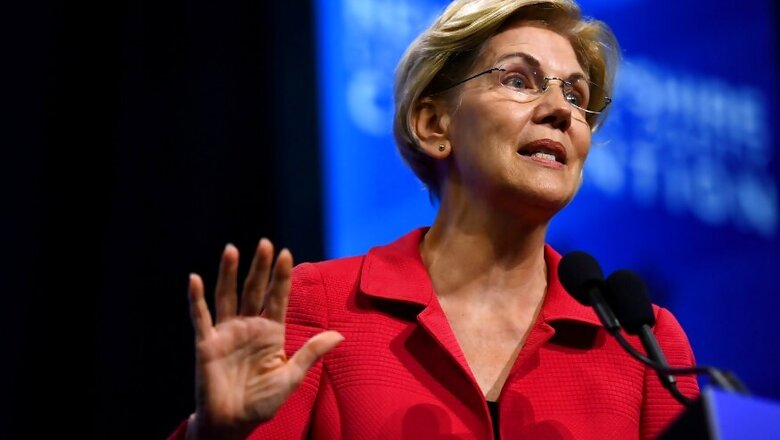
views
The New York Times editorial board broke with tradition to endorse not one but two candidates for the 2020 Democratic presidential nomination, backing Elizabeth Warren and Amy Klobuchar in a big push for the only two female senators still in contention.
The endorsements acknowledge a burning need for the superpower to have its first female commander-in-chief in the Oval Office after coming tantalizingly close in 2016 with Hillary Clinton. While Clinton, the NYT pick the last time, lost in one of the biggest upsets to Republican Donald Trump, the newspaper's positioning has reignited the hope by picking Warren and Klobuchar over former Vice President Joe Biden and Senator Bernie Sanders, the front-runners.
"Ms. Klobuchar and Ms. Warren right now are the Democrats best equipped to lead that debate… May the best woman win," the editorial board wrote, describing Massachusetts senator Warren as the "radical" and Minnesota senator Klobuchar as the "realist" choice.
Explaining the decision to back two candidates and both women this time, the board said, "Some in the party view President Trump as an aberration and believe that a return to a more sensible America is possible. Then there are those who believe that President Trump was the product of political and economic systems so rotten that they must be replaced. In this perilous moment, both the radical and the realist models warrant serious consideration. For this reason, we are breaking with convention and putting our support behind, not one, but two candidates."
Elaborating on the choice, the board said that while it doesn’t agree with some of Warren’s policy proposals, “we are struck by how effectively her message has matched the moment”. “Senator Warren is a gifted storyteller and a brilliant architect of regulation,” it said.
For Klobuchar, it said, "Senator Klobuchar has a lengthy resume and the Senate, and bipartisan credentials that make her an invaluable dealmaker, she's shown she can unite the party, and perhaps the nation."
So What is The New York Times Editorial Board
The editorial board, comprising 14 writers and editors from the New York Times Opinion department, was established by the liberal newspaper’s first publisher Adolph Ochs in 1896.
New York Times says the editorial board is separate from the news operations. To drive home this distinction in operations, the paper says the first time anyone in the newsroom learnt of the board’s editorial write-up on President Donald Trump’s impeachment inquiry was when it was first published.
“The role of the editorial board is to provide Times readers with a long-range view formed not by one person’s expertise and experience but ballasted by certain institutional values that have evolved across more than 150 years. That’s why the editorials, unlike other articles in The Times, appear without a byline,” NYT says.
Past Endorsements and What’s Different This Time
The NYT editorial board has a 160-year-old history of endorsing presidential candidates, beginning with Abraham Lincoln, a Republican, in 1860. Up until 1880, the paper endorsed Republicans, but switched it up with Democrat James Garfield who went on to become president in 1884. Since then, the liberal newspaper has stuck to endorsing Democrats, barring a few spells in 1940s and 1950s. The last Republican it endorsed was President Dwight D Eisenhower in 1956.
This is the second consecutive time the paper has endorsed a woman. It had backed former first lady and Secretary of State Hillary Clinton, the woman in US history to win presidential nomination from a major party, against Trump in 2016.
In yet another first this time, The Times detailed its decision-making process on its FX television show "The Weekly".
The episode shows the editorial board's interviews with nine leading Democratic presidential hopefuls. In addition to Warren and Klobuchar, NYT spoke with Joe Biden, Sanders, billionaire activist Tom Steyer, entrepreneur Andrew Yang, South Bend mayor Pete Buttigieg, former Massachusetts governor Deval Patrick and New Jersey senator Cory Booker, who dropped out of the race in December.
The interviews were conducted on the record. In addition to showing video clips of the interviews in the "Weekly" episode, the Times Opinion section also published interview transcripts.
The Significance of 2020 Endorsements
With no candidate yet to carve out a clear lead less than three weeks to go before the first votes in the nominations battle, an endorsement for Warren, amid a rift with Sanders, is particularly crucial. Each candidate is desperate for a breakout moment that could give them the vital momentum heading into the Iowa caucases on February 3 which begins the presidential primary season.
Elizabeth Warren has consistently polled at third place, behind former vice president Joe Biden and Vermont Senator Bernie Sanders -- Warren's fellow progressive. She surged during the summer but has seen her support slide since October.
Polling is tight in Iowa, with Biden at 20.7 percent support and Sanders, Buttigieg and Warren all less than five percentage points back, according to a RealClearPolitics average of polls. Klobuchar, credited with a crisp performance in the previous debate, was well behind, at seven percent. Steyer is at 2.7 percent.
The endorsement interviews made public by NYT editorial board are an in-depth dive into the candidates’ positions and campaigns, offering voters a close scrutiny as the contenders are asked tough questions.
Does it Work?
The paper, however, admits that the impact of the endorsements hasn’t been clear or consistent. Citing the example of 1897, an NYT article said most New York publications had backed the losing candidate, leading to questions on whether the endorsements have any real resonance with the voters. The trend turned from 1940 to 2016, however, when candidates with most endorsements won the presidential battle.



















Comments
0 comment